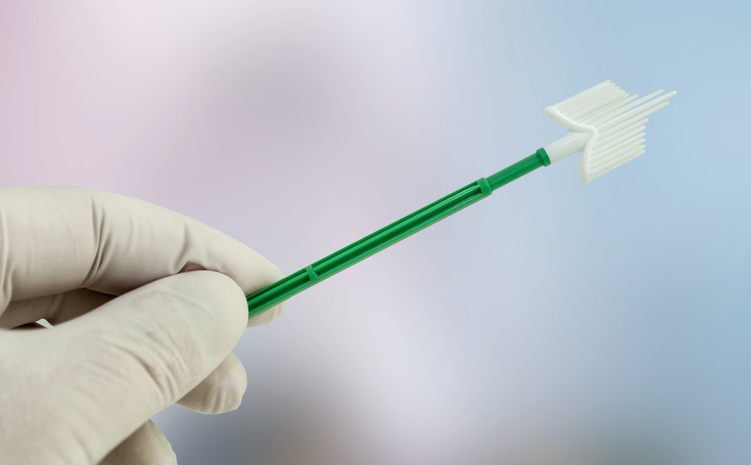
Source: AaronAmat / Getty
If you own a cervix, you’re probably familiar with that awkward feeling of lying on a cold examination table with your feet up in stirrups and legs spread eagle while your physician scraps your inner girl parts. Pap smears have been a dreaded but essential part of women’s healthcare for nearly 100 years, says the National Library of Medicine. But, a new type of test might mean this uncomfortable and sometimes painful procedure is a thing of the past – for some.
There’s a new type of screening that’s proven to be more accurate, and less painful, than a pap smear. It’s called an at-home cervical screening. Doctors have been performing in-office cervical screenings for some time, but recently select countries have started offering at-home kits that allow women to perform these tests in the comfort of their homes. This is huge news, because Cancer.gov reports that the number of women overdue for cervical cancer screenings has been increasing. Hopefully, a new at-home test will encourage more women to stay up to date on this important test. Here’s what you need to know about at-home cervical screenings.
Pap Smears Vs. Cervical Screenings

Source: Lalocracio / Getty
During a pap smear, a doctor or nurse collects a sample of cells from a woman’s cervix. For in-office cervical screenings, the procedure is identical. However, it’s at the lab where things change. Pap smears look for changes in cells that could be signs of pre-cancer (cervical cancer). Cervical screenings look specifically for human papillomavirus (HPV) infection. Cervical cancer screenings are able to identify cervical cancer risks in patients earlier than pap smears can.
The screening schedule differs, too. The current recommended guideline states that you should have a cervical screening following your next pap smear (on the condition that it’s normal). If that screening is normal, you can wait five years until your next one. The reason for this is because cervical cancer takes a long time to develop. If your screening is negative for HPV, even if you contracted HPV the next day, doctors say it is highly unlikely cancer would develop for many years.
*Research has found that the at-home tests are as accurate as the in-office screenings.
Who Should Get Cervical Screenings?

Source: solidcolours / Getty
The current guidelines state that women between the ages of 25 and 74 who are or have ever been sexually active should be screened. The minimum age recently increased from 18 to 25, due to the fact that most women under the age of 25 are now vaccinated for HPV. Additionally, cervical cancer is extremely rare in women under 25.
This screening is only appropriate for women who are not exhibiting symptoms of cervical cancer. Women who are experiencing irregular bleeding, pain or discharge should not do this screening and should speak to their doctor.
The At-Home Cervical Screening

Source: SeventyFour / Getty
If the idea of collecting your own cervical cells makes you uneasy, there’s good news: the at-home cervical screening involves taking samples from the vagina, not the cervix. Here’s how it works: your doctor either mails you the kit or hands it to you at your next in-person visit. In the privacy of your home, you conduct the test. This involves using the provided swab, inserting it just over one inch into the vagina and rotating it for 20 to 30 seconds. You’ll put the swab in the provided receptacle and mail it into the lab.
After that, you’ll receive results and after-care instructions. If your test is normal, no further care is needed for five years (the time of your next screening). Abnormal results might result in a visit to your doctor.
Why This Is A Big Deal

Source: PeopleImages / Getty
Nearly 90 percent of deaths due to cervical cancer are in women who are not up to date in screenings, and half of the cervical cancer cases are in women who do not get screened, says Kaiser Permanente. There are many hindrances to screening, though. Some women struggle to visit a doctor in person, due to their location or transportation issues. Additionally, some women are uncomfortable with the in-person visit and are even triggered by the traditional test due to past trauma.
The introduction of an at-home test can remove these obstacles and increase screening rates. In fact, Kaiser Permanente reports that they have already seen the success of at-home tests. Since introducing at-home colorectal cancer tests, screening rates have increased substantially for this cancer. The medical community has high hopes for what this could mean for cervical cancer rates moving forward.
To date, the U.S. Food and Drug Administration has not approved of the test. But major medical groups are working hard to prove the importance of these tests.
RELATED CONTENT: Black Women Two Times More Likely To Die Of Cervical Cancer Than White Women. Dr. Jackie Says ‘Early Detection Is Your Best Protection’









